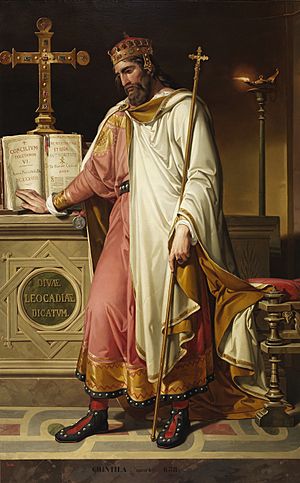Chintila facts for kids
Chintila (born around 606 – died December 20, 639) was a Visigothic King who ruled over Hispania (modern-day Spain and Portugal), Septimania (part of modern-day France), and Galicia starting in 636. He became king after Sisenand died and ruled until his own natural death.
Chintila was known for holding important meetings called the Councils of Toledo. He was also a poet. After he died, his son, Tulga, became the next king.
Quick facts for kids Chintila |
|
|---|---|

Imaginary portrait of Chintila by Bernardino Montañés in the Museo del Prado. Oil on canvas, 1855
|
|
| King of Hispania | |
| Reign | 636 – 20 December, 639 |
| Predecessor | Sisenand |
| Successor | Tulga |
| Born | c. 606 |
| Died | 20 December 639 |
| Issue | Tulga |
Contents
Chintila's Time as King
Chintila became king in 636 after the previous king, Sisenand, passed away. We don't know if Chintila was related to Sisenand. It's also not clear exactly how Chintila became king. Both kings had difficult reigns, facing challenges from others who wanted the throne.
During his rule, Chintila called two important meetings in a city called Toledo. These were the Fifth Council of Toledo in 636 and the Sixth Council of Toledo in 638.
What Was Discussed at the Councils?
The Sixth Council of Toledo talked about many things. They discussed rules for the church and laws for the kingdom. They also talked about the rights of citizens and property laws.
A big topic was what kind of person could be king. They decided that only someone from a noble Visigothic family could rule. About 53 church leaders, like bishops, attended this important meeting.
Laws About Religion
As king, Chintila wanted everyone in his kingdom to be Christian. He made laws that made it difficult for people who were not Christian to live there. The Sixth Council of Toledo praised him for these efforts. They even asked God to give the king a long life.
Earlier, King Sisebut (who ruled from 611 to 620) had also made laws about religion. He wanted people to change their religion to Christianity. Later, the Fourth Council of Toledo did not agree with these earlier practices. However, Chintila brought back similar rules, and the councils during his time approved them.
Chintila's laws set the stage for future Visigothic kings. These kings continued to make rules about religion. For example, around 650, people living among the Visigoths had to promise King Recceswinth that they would follow Christian teachings. This was even if they had been forced to become Christian under King Chintila.
The Visigothic Code, which was a set of laws, also supported Chintila's rules. One part of this law code specifically said that Visigothic citizens could not protect people who were not Christian in the kingdom.
Chintila and the Pope
King Chintila also wrote poetry. His poems showed the popular style of his time. One poem was sent to Pope Honorius I. This was either just before or just after the Pope died.
Chintila also gave a special covering, called a "velum," to St. Peter's Basilica. This gift had a poem on it. The poem praised Pope Honorius and St. Peter. It also included a prayer for salvation. Chintila's communication with the Pope showed his strong commitment to Christianity.
See also
 In Spanish: Chintila para niños
In Spanish: Chintila para niños

